You’re shopping for a guitar and you have an idea in your head of what you want to buy. You’ve thought about what brand and models you like, what colors are your favorite, what pickups and hardware suit you.
You’ve probably even been watching reviews and demos to hear how it sounds, but have you considered the shape of the neck of your guitar?
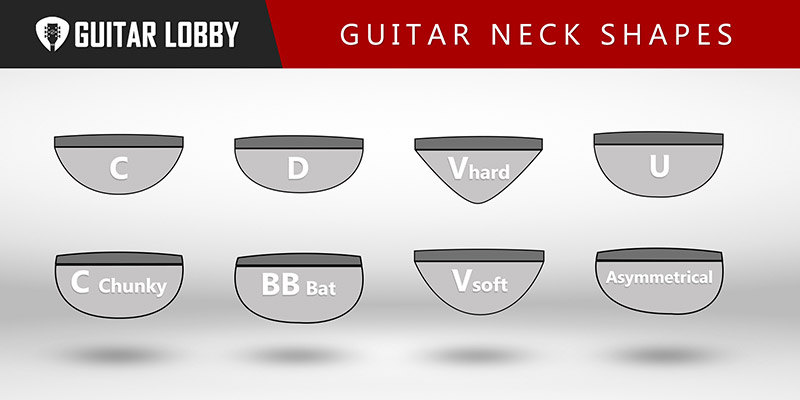
The neck of your guitar is big deal when it comes down to overall playability and being comfortable with your instrument in the long run. While it may sound complicated, it is a straightforward concept to understand. There are four standard neck shapes C-shape, U-Shape, V-Shape, and the more modern D-shape, and while they all look and feel different.
Table of Contents
You will notice quickly that not all will not feel comfortable in your hand. You will learn in your time playing the guitar that not all guitars are made the same and that each guitar has a different feel to the neck from the fretboard to the back of the neck.
We will discuss each shape in detail below, but here is a good video from Fender Custom Shop:
While you could blindly order a guitar without doing the research, you could luck out and love it; on the other end, you could hate it and find it unplayable, and that’s we will go over so that you will have the tools available to you and you can find the right instrument to learn and grow with.
Before going into too much detail, it must be said that the neck shape will not affect the sound of your guitar; however, change how you play it. There is no neck shape out there that will be better for soloing, jazz licks, or jamming out to your favorite rock riff. The neck you decide to choose all comes down to comfort and playability.
You may be asking yourself now, “what do these letters even mean, and how does it affect me in the grand scheme of things?”.
To begin with, all guitar brands today use the standard C, U, and V shape to designate neck profiles. Some companies use the less common D shape, these all refer to the back of the neck and the section, and each one has varying depths. Let’s dive into more detail and see what each of these necks brings to the table.
Here Are the Most Common Guitar Neck Shapes (With Explanations)
1. C-Shape Neck and C-chunky
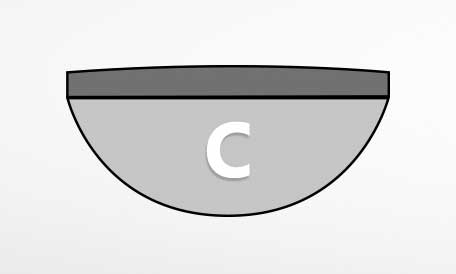
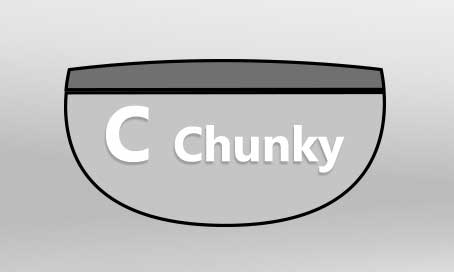
The most common neck shape you will see on the market today would be the C-Shape neck standard on most, if not all, fender made models. The C-shape is rounded into an oval profile, making it very comfortable for anyone but those with larger hands while not being cut as deep as the U or V-shaped neck. This neck shape hit its prime in the 1980s when Fender decided to make this their neck shape of choice and bring it into the modern era with the contemporary C neck, also known as the “flat oval” C neck.
Most Modern Guitars use this neck shape due to the all-around comfort and playability it gives. You might notice when you try a Fender, they may have a flatter c-shape than others, but the basic shape is still there;
The C-shape neck offers a multitude of different options for players including:
- Slim
- Extra-Slim
- Fat
- Nut-Shaped
- Huge
For context, the huge c-shape neck offers little to no taper from the first fret to the 12th fret (Crazy stuff, right?). Due to the C-Shaped neck being relatively thin and rounded, it is great for most players, especially if you enjoy the feeling of your thumb free, instead of touching the neck itself.
Notable guitars that have C-Shaped necks:
- Fender American Standard Series
- Fender American Special series
- Ibanez JEM, JCM
- 59’ Gibson SG
2. U-Shape Neck and BB Bat
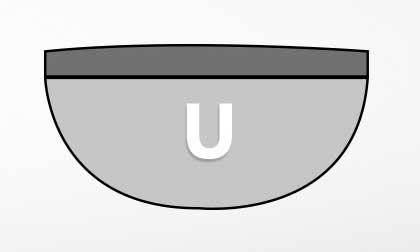
This neck is massive in size and is chunkier and more rounded than the C-shape neck and is a very comfortable neck for those with larger hands. This neck shape is lovingly referred to as the “baseball bat” due to the almost rectangular shape it has. It is a very comfortable design for those with longer fingers to help give a more comfortable reach around the fretboard.
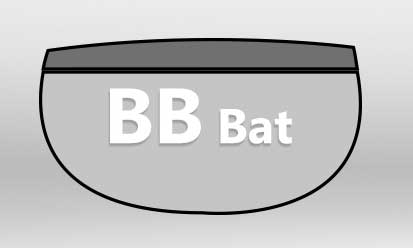
Many older Fender models stuck to this u-shape, such as the 1953 telecaster, and most reissue telecaster guitars today still use this shape neck. In the 50s, Gibson Les Paul’s were known far and wide for the “Baseball Bat” style necks, and they even use these on their reissue models to give them that classic feel and have felt as close to the original as possible, and as the years went on Gibson started to move from these fatter necks.
While the U-Shape is broad, that doesn’t necessarily mean thick Schecter makes a beautiful line of ultra-thin necks, so it doesn’t feel like such a handful like you would typically see in older U-shape necks.
Models that use the U-shape:
- Fender ‘70s Classic Stratocaster
- American ’52 Telecaster
- Gibson ES-355
- Schecter Banshee GT
- Gibson Les Paul Standard ‘50s
Related Popular Article: Most Common Types of Acoustic Guitars Explained
3. V-Shape (V-soft V-hard)
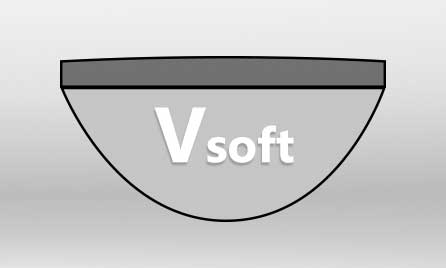
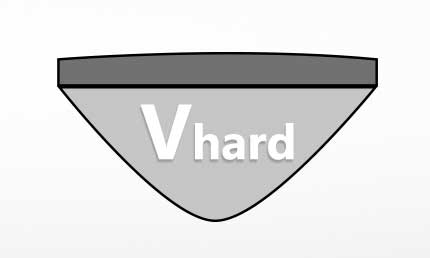
The V-shape neck is a much older design and runs in two separate variations, the soft V-shape and the hard V-shape. While they are both a similar shape, they both have a very different feel. The soft V-shape was created by a complete accident in the Fender factories back in the 1950s. As the name implies, the V-shape does come to a hard point. It has a more rounded shape and feels, these are great for players who feel comfortable with their thumb hanging over the fretboard while they play. That brings us to the hard V-shape. This shape has hard curves straight to the V-shape.
The V-shape is very uncommon today and usually only found on reissue models but is regarded as the more comfortable V-shape of the two. This shape neck is still used and loved by Eric Clapton, and Fender even made a replica model based on his Stratocaster that uses this neck shape.
Models that use the V-Shape neck:
- 50s Classic Stratocaster
- Eric Clapton Replica Stratocaster
- American Deluxe “V” Stratocaster
Related Popular Article: Best American Made Guitars
4. D-Shape Neck
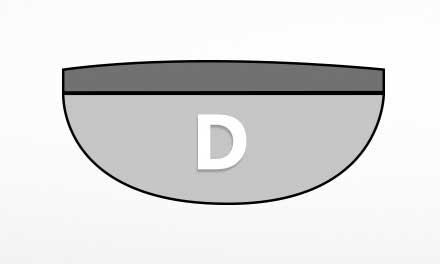
The D-shaped neck, also known as the modern flat oval, is a modern neck for electric guitars. This neck shape got its start on classical string guitars due to the almost flat feel on the back of the neck, making it feel very comfortable in your hands as the neck itself is flatter than the rest of the neck shapes. The shoulders of these guitars often protrude vertically and then go over the radius of the neck. The shape of this neck is often mistaken for a C-shape. As previously mentioned, it has flatter edges than the C.
This neck is excellent if you love playing fast-moving passages and using techniques that involve rapid movement between strings. The D-Shaped Neck is the latest neck to be used by guitar companies to this day, and it is prevalent on more modern guitars with brands like Ibanez and Epiphone. The D-shape is definitely one of of the most common guitar neck shapes.
Guitars with the D-shape neck include:
- Ibanez JP20
- Ibanez GB10
- Epiphone Sheraton II
- Epiphone Les Paul Standard
5. A-Symmetrical Neck
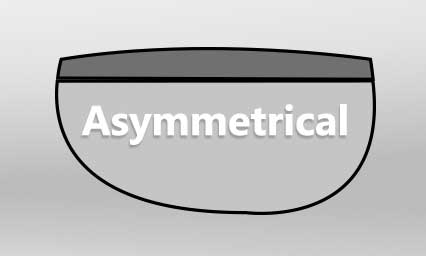
The A-symmetrical neck is a bit of a weird style neck which gets bulkier on one end of the neck and thinner going to the bottom of the neck. Imagine, if you will, if you start at the low E side of the neck, it gets thinner as it moves to the high e side, positioning the bulk of the neck in the hollow of your hand, reducing the thickness under your fingers. Having less wood under your fingers gives you a fuller shaped neck with easy playability; in a way, it gives you the best of multiple worlds from the previously mentioned neck profiles.
This style of necks is used mostly on signature models of guitars such as the Brad Paisley signature Telecaster. The models made by Eddie Van Halen’s Brand EVH models use a slim tapered A-symmetrical design as well as the 2018 Gibson Paul Standard, which also uses a slim tapered A-Symmetrical neck. Early A-symmetrical necks were usually the result of a mistake when the luthiers were building these guitars; little did they know those mistakes would make for a very comfortable guitar.
Guitars with A-symmetrical necks:
- 2018 Gibson Les Paul HP
- EVH Wolfgang Standard
- Brad Paisley Signature Telecaster
Related Popular Article: 17 Best Beginner Acoustic Guitars
What is a Fretboard Radius, And How Does It Affect Playability?
When choosing a neck shape, you might want to look into the fretboard radius of your guitar, and just like the neck shape, there are several different sizes you should know about when doing your research. The fretboard radius is the measure of the arc of its width. If you take a closer look at a guitar neck, you will notice that very few of these necks are ever genuinely flat and are slightly convex across the width. That is what the fingerboard radius measures.
Other stringed instruments, such as the classical guitar, banjo, and some steel-string guitars, have flat fingerboards, which means you will not see that same curvature on their fretboards. While Fender originally started with a 7.25” radius in the early years, they eventually moved to the 9.50” radius in the 1980s and kept it today on their modern Stratocasters and Telecasters. On the other hand, while Gibson varies slightly, their J-45 acoustic model has a 16” fretboard radius while most if not all of their electric guitar models sit in and a 10” to 12” radius.
While I mentioned a couple of radius sizes, there are a few more that vary to model these include:
- 7.25”- Typical of vintage fender models
- 9.50” Modern Fender
- 12” Gibson Les Paul
- 14”
- 15”
- 16”, 17”, and 20” Ibanez and other Newer Models
The general idea behind this is that the radius of the fretboard, much like the shape of the neck, fits the natural curvature of the human hand, making it comfortable for the player. A good rule of thumb to follow is that a more curved neck tends to be better when it comes to chording due to the natural curve of the human hand mentioned above, but with the pros, unfortunately, there are some cons to these curved necks, the strings become much more difficult to bend. The issue comes from the bend itself; when you bend the string, it is drawn to the center of the board, which is higher than the edge and can cause buzzing on a more curved board. To counteract this issue, the flatter fretboard was introduced. These boards often diminished the problem the rounded fretboards had and attracted more players that tended to bend their notes more.
While it is often generalized that rounded necks are better for chording and flatter necks are better for single note playing, it is always better to just get out there and play and figure out what feels comfortable for you.
As the years have gone on and guitar manufacturers have evolved into the companies we know today, they have started to address the strengths and weaknesses of the different fretboard radius by creating the compound radius. This ingenious idea took the fretboard and changes the radius as you move up and gives you the best of both fretboards.
What Are The Pros And Cons Of Having A Thin Neck Shape?
When you looking at the different guitar necks shapes there will be some tradeoffs and a lot of it just comes down to personal preference. If you have chosen a thinner neck, you may notice that it is much easier to play faster, and your thumb might not even be touching the neck at well when speeding through quick passages, and you will have much less wood getting in the way between you and the fretboard. However, there are some drawbacks to having a thinner neck.
Unfortunately, thinner necks tend to warp much easier than their thick-necked counterparts, putting much more responsibility on you- the player takes care of your instrument when the seasons change. If your necks do end up warping, it can be a miserable experience trying to repair. Ibanez has quite a few different models of thinner necks, including the JEM and the Wizard super.
What About Thick Neck Shapes?
Thick necks are far less likely to suffer from the mayhem described previously, they are much studier and are much less likely to warp, but the real drawback lies with the sheer size of some of these necks. If your hands are smaller than average, you will feel some significant discomfort in your hands struggling with one of these. The best advice would be never to go too far outside of your natural range of motion; you want to be comfortable with your instrument and continue playing without any pain in the years to follow.
There are also thinner U and V-shaped necks, like the Heritage H-150 that offer a more modern take these classic necks without the tension on your thumb tendon, so that gives you more options if you love these classic neck profiles, but your hands are on the smaller side, you can still have that option open for you.
Bolt-On Neck
Along with the shape of the neck, you have the choice of a “bolt-on” neck or a “set” neck. The bolt-on neck, while being on the cheaper end, is still a fantastic concept, these necks are often interchangeable, making repairs as quick as taking a few bolts out and slapping a new neck on and restringing, and you are good to go. Most Fender guitars have the bolt-on necks, along with most T-type and S-type models. These necks often give a snappier and “twangy” tone, but it is sometimes harder to reach the upper frets with these necks.
The neck is bolted on: However, there is a small gap between the neck and body that slows the sustain compared to set necks. The best part of a bolt-on neck is that you always have different options. Fender sells aftermarket necks with different profiles and fretboard radii, so you will always have a multitude of options for comfort when it comes to the neck of your guitar. A few excellent examples of bolt-on necks would be the Fender Stratocaster and some of the cheaper Epiphone Les Pauls.
Set Neck
The set neck is a two construction where the neck is glued to the body; these necks offer warm tones and great sustain. The drawback with Set necks you have a few more issues when it comes to repairs and cost, these guitars often cost much more than a guitar with a bolt-on neck, and damaging a set neck usually is much more costly. Usually, it involves taking it in to have it professionally repaired by a luthier or, in some unfortunate cases having the guitar replaced completely. You are also stuck with the neck shape guitar made with, again, why picking a comfortable guitar is extremely important.
Since the neck is connected by glue, the issue mentioned above is non-existent, and you can achieve better sustain and resonance. You will also have a warmer, fuller tone with this design. Most companies, such as Gibson and PRS, use this method. Some great examples of this neck would be the Gibson Les Paul or the PRS custom 24.
Neck-Through
Neck-Through or Neck-Thru is more common in high-end guitars. The neck is not bolted on; the neck is the body. The wood that makes up the guitar’s neck also makes up the middle section of the body itself. This section is used to mount the bridge, saddle, and pick-ups for the best possible sustain and resonance of the three. The rest of the guitar is made of separate pieces of wood, commonly referred to as wings, and the middle neck-through piece gives the builder a great opportunity to bind different types of wood together.
Schecter and Ibanez have made some beautiful guitars that offer excellent neck stability through this process. They can use three, five, or even seven different pieces of wood to make these models giving a unique tone. The tonal-transfer between the neck and body is better than both the bolt-on and the set-neck giving these guitars a much warmer, fuller sound and offers the best overall sustain and resonance. While this style of the neck has some great features, it does have a few drawbacks. Depending on how many pieces of wood are used to build the guitar’s body, you run into the issue you have with the bolt-on neck on a much larger scale. Image the sustain and resonance you lose from the gap on the bolt-on neck. It might not seem like a lot, but imagine multiplying by three, or five, or even seven.
Unfortunately, now matter tightly, the wood is glued together, there are still gaps where the pieces of wood were glued together, causing you to lose quite a bit of tone. One part of mahogany or maple will have consistent density rather than seven different pieces. The Neck-thru design is a much sturdier design with minimal need for repair and is known for its strength in maintaining a low action without moving the wood. This configuration is complicated to produce and is the most expensive of the three.
So Which Neck is Right for You?
So now that I have overloaded your brain, the question that may be on your mind now is “Okay, I know what these shapes are, so which guitar is right for me?” and while I wish I had that answer for you, the only real solution I can give is to try them out. Go to your local music shop, pick up the guitar and play, see what feels comfortable in your hands because what is comfortable in your hands might not feel that same to someone else. If you are unable to go to a shop and try out an instrument, call the shop up and ask them, and they will be happy to help you out. The best advice I can give would be “try before you buy” choosing your instrument is a big decision. Do your research and see what is available to you; that is why advantages and disadvantages are presented to you to pick the best option for you quickly. Just remember, comfort is vital.
The neck of your guitar is the most critical decision when you are planning to buy it. Take the time to learn these shapes, what fits your hand, what feels comfortable to you, because, as I said, it can be miserable and could even be painful if you pick your guitar solely on looks alone. Find the guitar that fits your style, what genre of music you want to play, do you plan on doing more soloing and single-note playing, or plan on riffing it out and mostly playing chords. All of these choices matter in what instrument you should buy, take the time to learn your style, and what sound you want. Take your time and try as many guitars as possible so that you can make an informed decision. The time you put into learning more about your guitar could save you months of torture down the line saving you time, money, and sanity. Use the knowledge to find your perfect guitar, making you a better, happier player for years to come!

My name is Chris and I’ve had a passion for music and guitars for as long as I can remember. I started this website with some of my friends who are musicians, music teachers, gear heads, and music enthusiasts so we could provide high-quality guitar and music-related content.
I’ve been playing guitar since I was 13 years old and am an avid collector. Amps, pedals, guitars, bass, drums, microphones, studio, and recording gear, I love it all.
I was born and raised in Western Pennsylvania. My background is in Electrical Engineering, earning a Bachelor’s degree from Youngstown State University. With my engineering experience, I’ve developed as a designer of guitar amplifiers and effects. A true passion of mine, I’ve designed, built, and repaired a wide range of guitar amps and electronics. Here at the Guitar Lobby, our aim is to share our passion for Music and gear with the rest of the music community.
